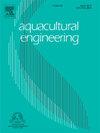Effects of light intensity on the behavioural response and physiological parameters of rainbow trout (Oncorhynchus mykiss)
IF 3.6
2区 农林科学
Q2 AGRICULTURAL ENGINEERING
引用次数: 0
Abstract
Light conditions play a pivotal role in enhancing the welfare of rainbow trout (Oncorhynchus mykiss) in deeper-offshore aquaculture systems in China. However, optimal light intensity and duration for improving rainbow trout welfare remain unclear due to limited foundational knowledge. This study investigated the effects of different light intensities (control group L0: 0 lx; treatment groups L1: 42.8 lx, L2: 59.0 lx, L3: 63.5 lx, L4: 73.0 lx) and exposure durations (1 hour and 7 days) on the behavioural responses and physiological parameters of rainbow trout. Behavioural tests measured the frequency of fish crossing a light curtain during a 10-minute period, while physiological parameters including plasma cortisol, total protein (TP), albumin (ALB), triglyceride (TG), total cholesterol (TC), aspartate transaminase (AST), and alanine transaminase (ALT) were assessed after 1-hour and 7-day treatments. Results reveal that the rainbow trout exhibits the highest crossing frequency under L1, alongside significantly lower levels of cortisol, TP, TG, TC, and AST compared to higher light intensities. In contrast, higher light intensities (L2, L3, and L4) cause increased stress, reflected by elevated plasma cortisol, protein, lipid, and enzyme levels. There are no significant differences in behaviour or physiological responses between L0 and L1. These findings imply that L1 represents a balanced light intensity that supports natural swimming behaviours with minimal stress, while higher intensities induce elevated stress. Therefore, a light intensity of 42.8 lx (L1) is recommended to enhance fish welfare in deeper-offshore aquaculture systems when artificial light is utilized.
光照强度对虹鳟行为反应及生理参数的影响
在中国深海养殖系统中,光照条件在提高虹鳟鱼(Oncorhynchus mykiss)福利方面发挥着关键作用。然而,由于基础知识有限,改善虹鳟鱼福利的最佳光照强度和持续时间尚不清楚。本研究考察了不同光照强度(对照组L0: 0 lx;L1: 42.8 lx, L2: 59.0 lx, L3: 63.5 lx, L4: 73.0 lx)和暴露时间(1 小时和7天)对虹鳟鱼行为反应和生理参数的影响。行为测试测量鱼在10分钟内穿过光幕的频率,而生理参数包括血浆皮质醇、总蛋白(TP)、白蛋白(ALB)、甘油三酯(TG)、总胆固醇(TC)、天冬氨酸转氨酶(AST)和丙氨酸转氨酶(ALT)在治疗1小时和7天后进行评估。结果表明,与高光照强度相比,虹鳟鱼在L1下表现出最高的交叉频率,同时皮质醇、TP、TG、TC和AST水平显著降低。相反,较高的光强度(L2、L3和L4)引起应激增加,反映为血浆皮质醇、蛋白质、脂质和酶水平升高。L0和L1在行为和生理反应上没有显著差异。这些发现表明,L1代表了一种平衡的光强度,支持自然游泳行为的最小压力,而更高的强度会导致更高的压力。因此,在使用人工光的深海养殖系统中,建议使用42.8 lx (L1)的光强度来提高鱼类福利。
本文章由计算机程序翻译,如有差异,请以英文原文为准。
求助全文
约1分钟内获得全文
求助全文
来源期刊

Aquacultural Engineering
农林科学-农业工程
CiteScore
8.60
自引率
10.00%
发文量
63
审稿时长
>24 weeks
期刊介绍:
Aquacultural Engineering is concerned with the design and development of effective aquacultural systems for marine and freshwater facilities. The journal aims to apply the knowledge gained from basic research which potentially can be translated into commercial operations.
Problems of scale-up and application of research data involve many parameters, both physical and biological, making it difficult to anticipate the interaction between the unit processes and the cultured animals. Aquacultural Engineering aims to develop this bioengineering interface for aquaculture and welcomes contributions in the following areas:
– Engineering and design of aquaculture facilities
– Engineering-based research studies
– Construction experience and techniques
– In-service experience, commissioning, operation
– Materials selection and their uses
– Quantification of biological data and constraints
 求助内容:
求助内容: 应助结果提醒方式:
应助结果提醒方式:


